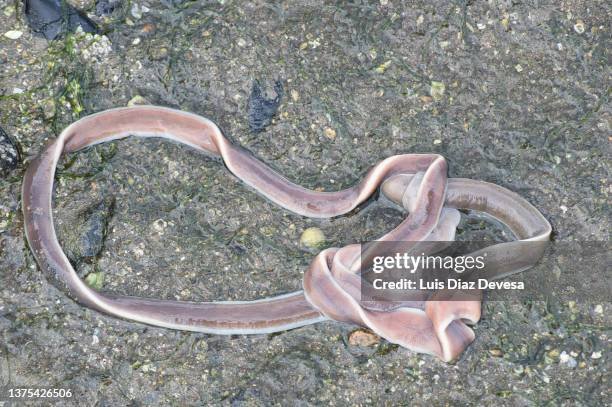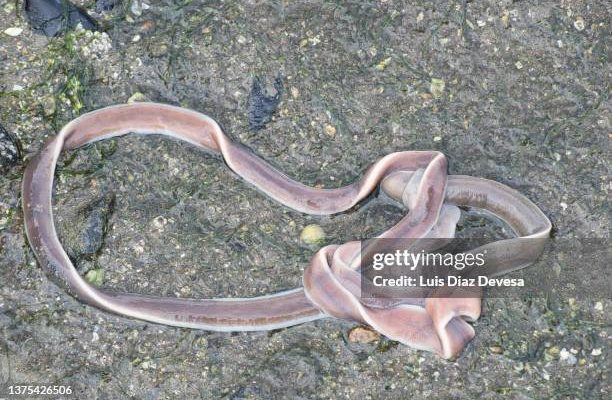
Now, ribbon worms, or *Nemertea*, are not just your average worm. They can grow to remarkable lengths and have a unique way of moving, eating, and hiding. During low tide, their behavior changes dramatically. So, let’s dive into the world of ribbon worms and discover what makes them tick during these tidal shifts.
What Are Ribbon Worms?
Ribbon worms are soft-bodied, elongated creatures that mostly call the ocean home. They can be found in a variety of colors and sizes, with some species stretching over 30 feet long! Imagine that—a worm longer than a bus. They’re not worms in the way we think of earthworms. These guys have quite a few tricks up their sleeves, making them unique members of the marine ecosystem.
One key feature of ribbon worms is their proboscis, a tubular structure they use to catch prey. When they sense potential food, they can extend this proboscis with impressive speed to capture small crustaceans or worms. This method is like having a super-fast fishing line at their disposal. During low tide, when their usual hunting grounds may be exposed, they rely on their ability to camouflage and burrow into the sand or mud to avoid danger and find food.
When examining ribbon worm behavior, you’ll notice they thrive in diverse habitats. They tend to prefer environments that offer plenty of places to hide, such as rocky shores or tidal pools. But when the tide recedes, the game changes.
The Impact of Low Tide on Ribbon Worms
Low tide can be quite the challenge for ribbon worms. When the water retreats, these creatures face a variety of threats, including predators like birds and crabs. To adapt, ribbon worms often retreat into the mud or sand to avoid being seen. It’s a bit like playing hide-and-seek, but with higher stakes.
During low tide, ribbon worms may also exhibit different feeding behaviors. They have to carefully choose their timing for feeding since they are more exposed. Some ribbon worms will wait patiently for the tide to come back in, while others will try to hunt in the exposed areas, taking advantage of the lower competition for food. Their ability to adapt their feeding strategy shows how resilient they can be, even when conditions aren’t ideal.
Additionally, low tide provides an opportunity for ribbon worms to move into new territories. With less water covering the ground, they can venture out to explore more areas in search of food or more suitable habitats. So, you might say low tide is like a buffet opening up for these crafty creatures.
Feeding Adaptations of Ribbon Worms During Low Tide
You might be wondering how ribbon worms manage to find food when their usual dining spots are out of reach. Their feeding strategies during low tide are as varied as the species itself. Some will remain tucked away in the mud, conserving energy until the tide returns, while others take the opportunity to hunt in shallow pools.
Ribbon worms generally feed on small marine organisms such as small fish, snails, and other worms. Their proboscis plays a critical role here. When hunting, they can extend this long, sticky appendage to snag prey. So, if you think about it, it’s like having a remarkable fishing rod that can reach out and catch breakfast!
Interestingly, some ribbon worms are more opportunistic feeders. They will scavenge for detritus or dead organisms that may have washed ashore during the tide. This behavior is crucial as it helps recycle nutrients back into the ecosystem, supporting other marine life. Talk about multitasking!
Camouflage and Predation Risks
One of the most fascinating aspects of ribbon worm behavior during low tide is their use of camouflage. When the tide goes out, they can easily blend in with their environment. This allows them to avoid being spotted by predators like sea birds. Their colors and textures often mimic the sandy or rocky substrates, making them nearly invisible. It’s a clever survival tactic.
During low tide, they face heightened risks. Predators, both above and below the surface, are actively hunting for food. Birds might swoop down for a meal, while crabs roam along the exposed areas looking for their next snack. Ribbon worms have adapted to this by positioning themselves carefully within the sediment and using their natural colors for camouflage. It’s a high-stakes game of hide and seek at the shoreline.
If a ribbon worm is discovered, it can escape by quickly retracting into the sand or mud. This quick getaway can save them from becoming someone’s dinner. Honestly, it’s impressive how much thought and strategy these creatures put into surviving in such a challenging environment.
Behavioral Changes as the Tide Rises
As the tide begins to rise again, ribbon worms exhibit some notable behavioral changes. They start to move back towards the water, often becoming more active. This is their cue to explore their surroundings and check for any missed food opportunities during the low tide.
At this point, you might see them extending their proboscis more frequently as they search for prey. They’re also more likely to venture into areas with shallow water again. You could think of them as kids running out to play once the rain stops. The rising tide brings a sense of relief and new possibilities.
However, this behavior isn’t without its risks. As they move out into the shallow waters, they still need to remain vigilant against predators. The ribbon worms are always on high alert, ready to retreat back into their hiding spots if danger appears. Their adaptability shows just how resilient these creatures can be.
Environmental Impact on Ribbon Worm Behavior
The changing environment plays a significant role in ribbon worm behavior during low tide. Factors like temperature, water salinity, and even pollution can influence how these worms behave. For instance, during a hot day, they may seek out cooler, damper areas to avoid desiccation when the tide goes out.
Moreover, pollution can threaten their food sources. If their typical prey is affected by contaminants, ribbon worms may have to adapt by finding alternative food. This might involve spending more time in areas where they can find less affected organisms. It’s all about survival.
Moreover, habitat destruction can impact these creatures directly. If the natural shorelines are altered due to human activity, it can lead to fewer places for ribbon worms to hide or hunt. In this sense, their behavior is a reflection of the health of the ecosystem. Healthy ribbon worm populations indicate a thriving marine environment.
In the grand scheme of the marine ecosystem, ribbon worms might seem small, but they play a significant role in their environments. Their behavior during low tide is just one aspect of their fascinating lives. Whether it’s through their unique feeding strategies, impressive camouflage, or adaptability to changing conditions, these creatures show incredible resilience.
Understanding ribbon worm behavior helps us appreciate the intricate balance of life along the coast. Every tidal change brings new challenges and opportunities for these remarkable creatures. So, next time you’re at the beach and witness the tide going out, take a moment to think about the clever little ribbon worms just beneath the surface—navigating their world with purpose and strategy.

